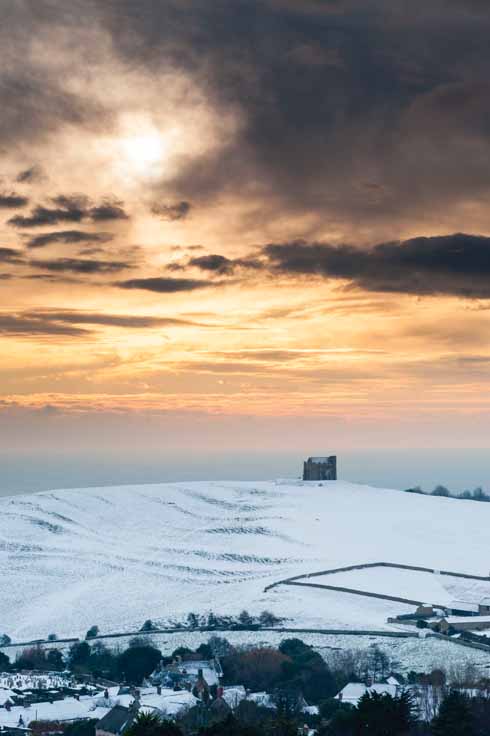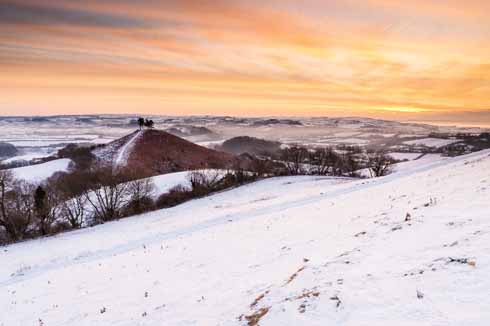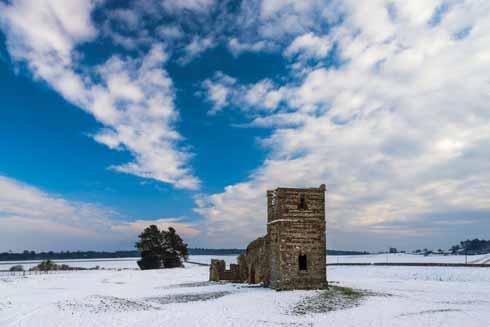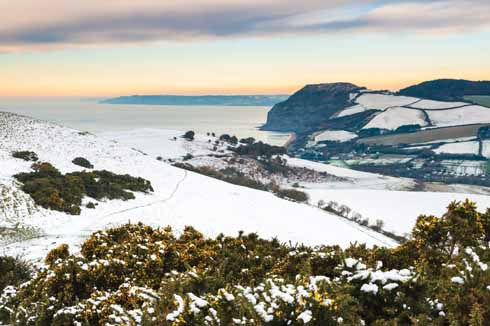In the bleak midwinter
Dorset is rarely affected as badly as some other counties, but as Graham Hunt’s pictures show, it’s still a transformative season
Published in January ’16

Eggardon Hill in the snow. The strip lytchetts are enhanced rather than obliterated by the snow thanks to the raking light.
In early December 2015, there was a good deal of talk about the effects of global warming and the attempts of developing and vulnerable island nations to set a target of a maximum increase in average temperatures of 1.5°C, not 2°C. Meanwhile the people of Cumbria and the North West once again surveyed the inadequacy of flood defences in the face of rain falling in biblical volumes in a 24-hour period as the strangely benign sounding Storm Desmond wrought havoc.

What could be more attractive than Gold Hill in Shaftesbury under a covering of snow, unless you’re at the bottom of it wanting to walk up
Weather is famously complex and climate even more so. Predicting the former is easier over the short term, predicting the latter easier over the long term. Trying to judge what our weather will be like, on average, over just a few years is difficult to do and is not made any easier by looking back over nearly a decade of Dorset winters; a pattern does not readily emerge.
Last year was, well, average, the year before much milder than average, the year before that slightly colder than average and the year before that (2011/12) milder than average. On balance, one might say that it’s been milder than average. Well, yes, to a point, and that point is the three years preceeding 2011/12 which were all colder than average.
None of this really makes a jot of difference to whether a landscape is covered in snow or not, though. Last February saw a beautiful snow covering of the county, but it was not by any means a cold winter.
There was the winter of 1891 when up to a dozen trains and their passengers were trapped in snowdrifts on tracks in the South and South West. Slightly further west from Dorset, a valley 300 feet deep was wholly filled with snow that did not completely thaw until June.
Within living memory, though, Dorset natives of a certain age will talk of the freeze of 1947. That year there was a frost every night for almost two months (16 January to 11 March, except for two days at the beginning of February). Older readers talk of walking over snow-covered fields and over hedgerows on the way to school without being aware of where the roads were, but navigating by the spires of churches.
Slightly younger readers will recall how, incredibly, the sea froze at Poole in 1962-1963, the coldest winter for 200 years in the country. Elsewhere in the country that winter, one farm in Dartmoor had been cut off by snowdrifts for 66 days by the time soldiers broke through the drifts, while when Halifax Football Club opened its gates for the first time in weeks, it was only as a public skating rink as the pitch was so frozen.
Shaftesbury is said to be an overcoat colder than Gillingham; Melbury Beacon is at least an overcoat colder than Shaftesbury when the wind whips in on a snowy day
For the white stuff, though, one only has to look back to 1978 for Dorset’s winter wonderland moment. As ever, winter tends to come deepest when it comes latest. After a sleety, occasionally freezing, January, by Monday 20 February 1978, fifteen inches of snow had fallen on Bournemouth over a single weekend and elsewhere in the county there were drifts all over the place.
No motor vehicles made it into Worth Matravers in that working week. The freezing spell that winter lasted barely 11 days, but whilst the county was in its grip, it was as cold and as beautiful as any of the mini ice-age Victorian winters, and the blizzards of 18-20 February were as impressive as anything the greybeards could remember. What will this winter hold in store for us? Well, if we knew that, we’d have nothing to talk about. ◗
❱ Graham Hunt is a freelance photographer who covered the county for the Dorset Echo until 2015. You can see more of his photographic work at
www.grahamhunt.net






